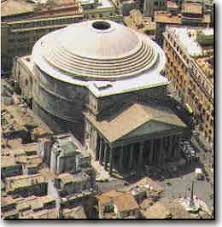Parthenon and Pantheon Comparison November 1, 2009
Posted by Allison in World History.trackback
Although their names are quite similar, the Parthenon and Pantheon , while alike, have some vital differences. These similarities and differences reflect the differences in Greek and Roman architecture. The Greek Parthenon was built between 447-432 BC, while the Roman Pantheon was constructed in 125 AD. Because of this, it is possible to observe the Greek influence on Roman art through a comparison of the two structures.
Above is a floorplan of the Parthenon. The Parthenon was built when Athens was at the height of its power. As evident in the floorplan above, there were Doric columns (represented by circles) completely surrounding the Parthenon. As Doric was not just a style of columns, but also a style of architecture, the Parthenon is in the Doric style. This means that there are certain designs on the top of the Parthenon called triglyphs and metopes. The Parthenon was constructed of marble.
Unlike the rectangular structure of the Parthenon, the Pantheon is topped with a dome. Although this is the most obvious difference, there are several other important differences. Instead of marble, granite and concrete were used to build it, granite for the columns and concrete for most of the rest of the structure. Also, in the Parthenon, light is let in between the columns, but in the Pantheon, it comes from the hole in the middle of the roof. However, the two structure also have several similarites. Both feature columns, which in the Pantheon are clearly a Greek influence. Also, the Pantheon is comprised of two circles, one verticle and one horizontal, which together form a sphere. This is a reflection of the Greek emphasis on geometrical perfection. They are also similar because both were used as temples.


Comments»
No comments yet — be the first.